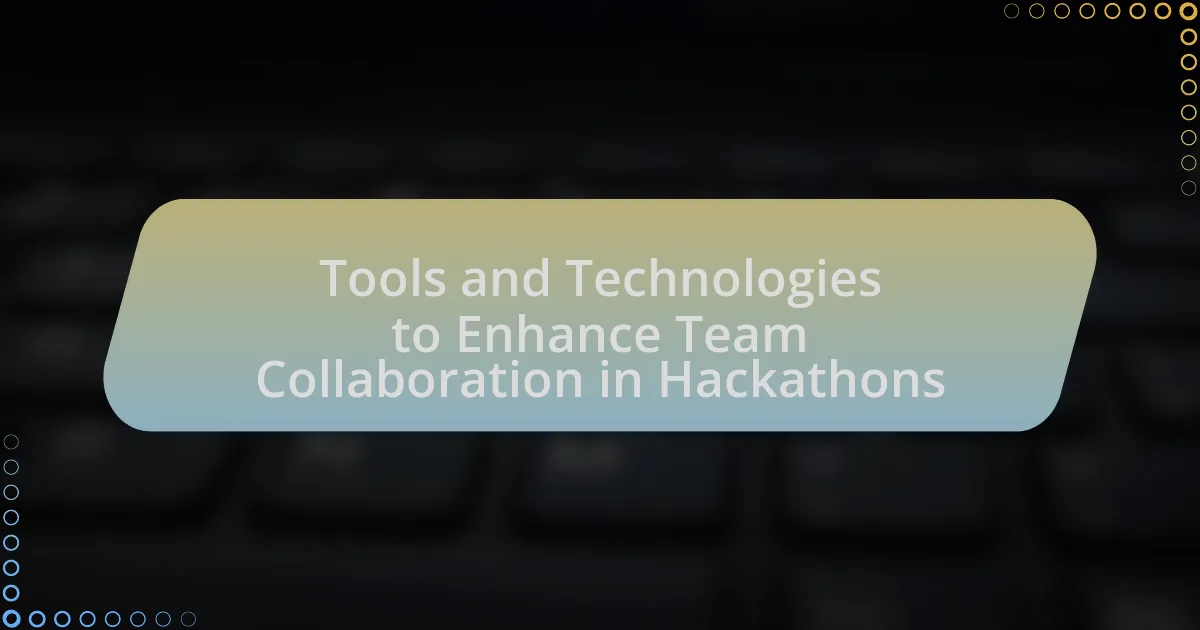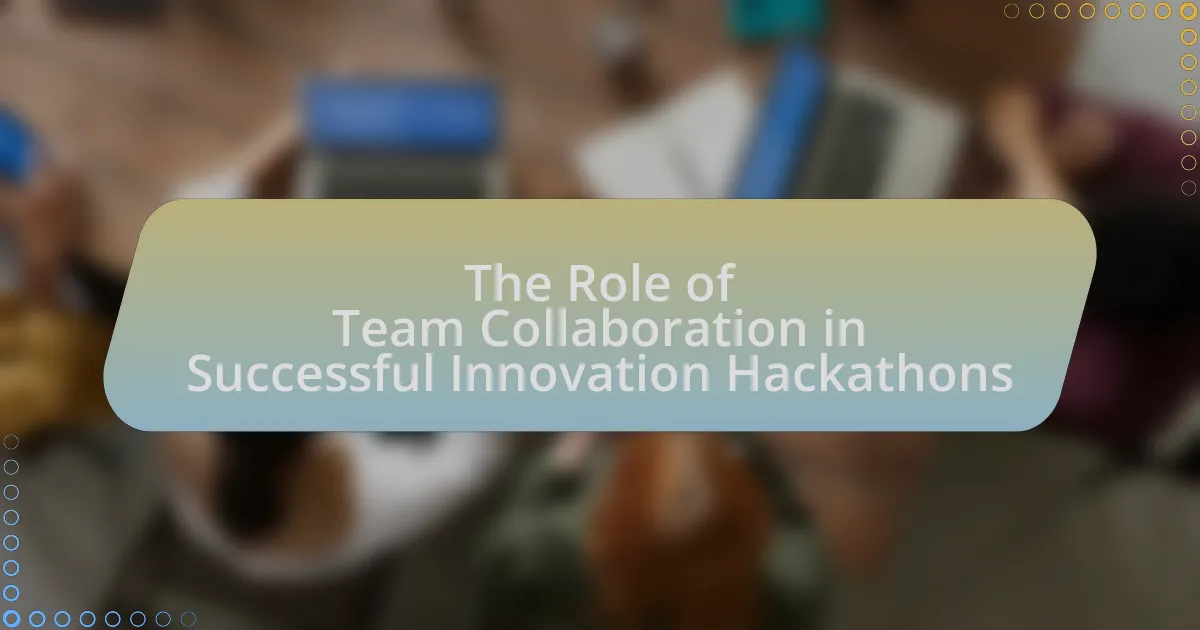The article examines the psychology of team collaboration in high-pressure hackathon environments, highlighting the impact of stress, communication, and psychological factors on team dynamics. It discusses the significance of collective efficacy, role assignment, and emotional intelligence in enhancing collaboration and innovation. Key challenges such as time constraints and interpersonal conflicts are addressed, along with strategies for effective conflict resolution and maintaining motivation. The article emphasizes the importance of psychological safety and the use of collaborative tools to optimize team performance in these intense settings.
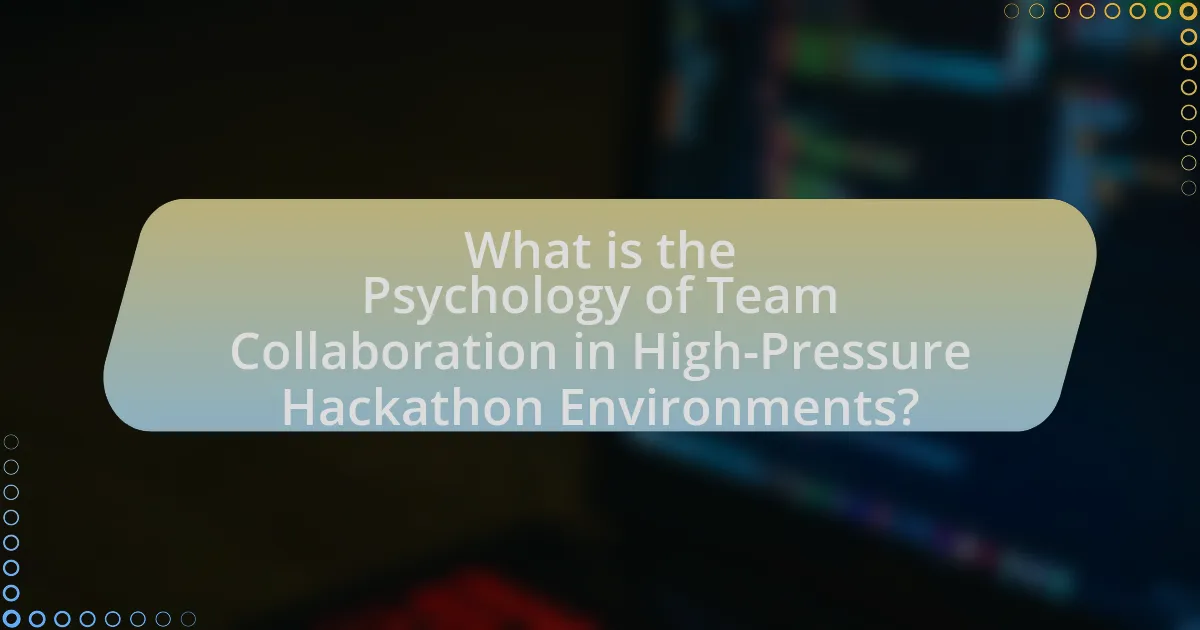
What is the Psychology of Team Collaboration in High-Pressure Hackathon Environments?
The psychology of team collaboration in high-pressure hackathon environments is characterized by heightened stress, urgency, and the need for effective communication. In these settings, teams often experience a phenomenon known as “collective efficacy,” where members believe in their combined ability to succeed, which can enhance motivation and performance. Research indicates that clear roles and responsibilities, along with a supportive team culture, significantly contribute to successful collaboration under pressure. For instance, a study published in the Journal of Business Research found that teams with strong interpersonal relationships and open communication channels are more likely to innovate and solve problems effectively during time-constrained events like hackathons. This underscores the importance of psychological safety, where team members feel comfortable sharing ideas and taking risks, ultimately leading to better outcomes in high-pressure situations.
How does team collaboration manifest in hackathon settings?
Team collaboration in hackathon settings manifests through intense communication, role distribution, and rapid problem-solving. Participants often engage in brainstorming sessions to generate ideas, which fosters a collaborative atmosphere. Teams typically assign specific roles based on individual strengths, enhancing efficiency and accountability. Research indicates that diverse skill sets within teams lead to more innovative solutions, as seen in the 2019 study by Hossain and Watanabe, which found that teams with varied expertise produced higher-quality projects. Additionally, the time constraints of hackathons encourage quick decision-making and adaptability, further solidifying collaborative dynamics.
What psychological factors influence team dynamics during hackathons?
Psychological factors that influence team dynamics during hackathons include stress levels, motivation, communication styles, and group cohesion. High-pressure environments like hackathons can elevate stress, impacting decision-making and collaboration. Motivation, driven by intrinsic factors such as passion for the project or extrinsic factors like competition, significantly affects team engagement and productivity. Effective communication styles, including openness and clarity, foster better collaboration and problem-solving. Additionally, group cohesion, which is the sense of belonging and unity among team members, enhances collaboration and overall performance. Research indicates that teams with high cohesion and effective communication outperform those lacking these psychological factors, demonstrating their critical role in hackathon success.
How do stress and time constraints affect team collaboration?
Stress and time constraints negatively impact team collaboration by increasing anxiety and reducing communication effectiveness. Under pressure, team members may become more focused on individual tasks rather than collective goals, leading to a breakdown in collaboration. Research indicates that high-stress environments can impair decision-making and creativity, which are essential for effective teamwork. For instance, a study published in the Journal of Applied Psychology found that teams under time pressure exhibited lower levels of cooperation and higher conflict rates, ultimately hindering project outcomes.
Why is understanding psychology important in hackathon collaboration?
Understanding psychology is important in hackathon collaboration because it enhances team dynamics and improves problem-solving efficiency. Effective collaboration relies on understanding individual motivations, communication styles, and conflict resolution strategies, which are all rooted in psychological principles. Research indicates that teams with a strong grasp of psychological concepts exhibit higher levels of trust and cohesion, leading to increased creativity and productivity. For instance, a study published in the Journal of Applied Psychology found that teams that engage in open communication and understand each member’s psychological needs are 30% more effective in achieving their goals during high-pressure situations like hackathons.
What role does emotional intelligence play in team success?
Emotional intelligence significantly enhances team success by fostering effective communication, collaboration, and conflict resolution. Teams with high emotional intelligence can better understand and manage their own emotions as well as those of their teammates, leading to improved interpersonal relationships and a more cohesive work environment. Research indicates that teams with higher emotional intelligence demonstrate greater adaptability and resilience, which are crucial in high-pressure settings like hackathons. For instance, a study published in the Journal of Organizational Behavior found that emotional intelligence positively correlates with team performance, highlighting its role in facilitating better decision-making and innovation under stress.
How can psychological safety enhance team performance?
Psychological safety enhances team performance by fostering an environment where team members feel safe to express their ideas, take risks, and admit mistakes without fear of negative consequences. This openness leads to increased collaboration, creativity, and innovation, which are critical in high-pressure settings like hackathons. Research by Google, known as Project Aristotle, found that teams with high psychological safety are more effective, as members are more likely to contribute and engage in discussions, ultimately leading to better problem-solving and project outcomes.
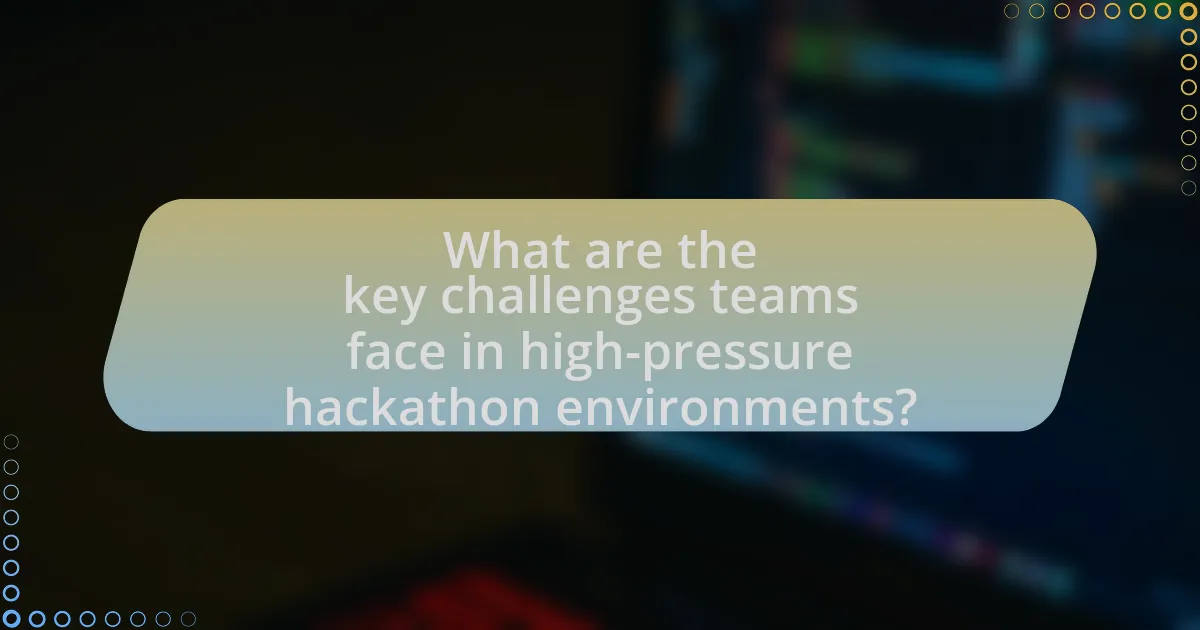
What are the key challenges teams face in high-pressure hackathon environments?
Teams face several key challenges in high-pressure hackathon environments, including time constraints, communication breakdowns, and stress management. Time constraints often lead to rushed decision-making, which can compromise the quality of the project. Communication breakdowns arise from the fast-paced nature of hackathons, where team members may struggle to share ideas effectively, resulting in misunderstandings or misalignment on goals. Additionally, stress management becomes critical as the pressure to perform can lead to burnout or conflict among team members, negatively impacting collaboration and productivity. These challenges are well-documented in studies on team dynamics under pressure, highlighting the importance of effective communication and stress management strategies in achieving successful outcomes.
How do interpersonal conflicts arise during hackathons?
Interpersonal conflicts during hackathons arise primarily from high-stress environments, differing communication styles, and conflicting goals among team members. The intense time constraints and pressure to produce results can lead to misunderstandings and frustration, as individuals may prioritize their ideas over collaborative input. Research indicates that diverse teams often experience conflicts due to varying perspectives and approaches, which can exacerbate tensions when under pressure. For instance, a study published in the Journal of Business Research highlights that stress can amplify emotional responses, leading to increased likelihood of conflict in team settings.
What strategies can teams use to resolve conflicts effectively?
Teams can resolve conflicts effectively by employing open communication, active listening, and collaborative problem-solving. Open communication allows team members to express their concerns and perspectives without fear of judgment, fostering an environment where issues can be addressed promptly. Active listening ensures that all voices are heard, which can lead to a better understanding of differing viewpoints and reduce misunderstandings. Collaborative problem-solving encourages team members to work together to find mutually acceptable solutions, promoting a sense of unity and shared purpose. Research indicates that teams that utilize these strategies experience higher levels of satisfaction and productivity, particularly in high-pressure environments like hackathons, where quick and effective conflict resolution is crucial for success.
How does competition impact collaboration among team members?
Competition can both enhance and hinder collaboration among team members. When competition is present, it can motivate individuals to perform at their best, fostering a sense of urgency and innovation that can lead to improved outcomes. For instance, a study published in the Journal of Applied Psychology found that moderate competition can increase individual effort and creativity, which can benefit the team as a whole. However, excessive competition may lead to a breakdown in communication and trust, as team members may prioritize personal success over collective goals. This dual impact highlights the need for a balanced approach to competition in collaborative settings, particularly in high-pressure environments like hackathons, where the stakes are high and teamwork is essential for success.
What are the effects of high-pressure situations on team morale?
High-pressure situations can significantly impact team morale, often leading to increased stress and decreased collaboration. When teams face tight deadlines or high stakes, individuals may experience anxiety, which can hinder communication and trust among team members. Research indicates that 70% of employees report feeling stressed in high-pressure environments, which can lead to burnout and disengagement. Furthermore, a study published in the Journal of Occupational Health Psychology found that teams under pressure often exhibit lower levels of job satisfaction and higher turnover intentions. These effects highlight the importance of managing stress and fostering a supportive environment to maintain team morale during challenging situations.
How can teams maintain motivation under stress?
Teams can maintain motivation under stress by fostering open communication and establishing clear goals. Open communication allows team members to express concerns and share ideas, which can alleviate anxiety and promote a supportive environment. Establishing clear goals provides direction and a sense of purpose, helping team members focus on achievable tasks rather than overwhelming challenges. Research indicates that teams with strong communication and defined objectives are more resilient in high-pressure situations, as they can adapt and collaborate effectively to overcome obstacles.
What are the signs of burnout in hackathon participants?
Signs of burnout in hackathon participants include physical exhaustion, emotional fatigue, decreased motivation, and impaired cognitive function. Participants often exhibit irritability, lack of focus, and a sense of detachment from their work. Research indicates that prolonged stress during intense events like hackathons can lead to these symptoms, as participants may work long hours without adequate rest or breaks, resulting in diminished performance and overall well-being. Studies show that nearly 50% of participants in high-pressure environments report experiencing burnout, highlighting the importance of recognizing these signs early to mitigate their impact.
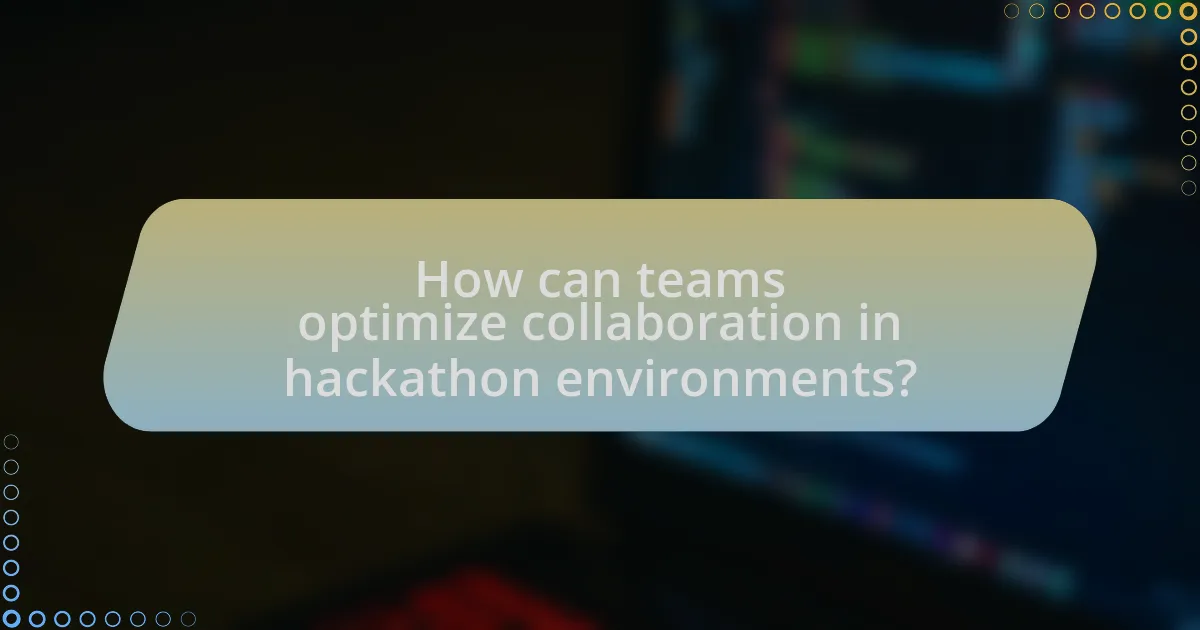
How can teams optimize collaboration in hackathon environments?
Teams can optimize collaboration in hackathon environments by establishing clear roles and responsibilities from the outset. This clarity helps each member understand their contributions, reducing overlap and confusion. Research indicates that teams with defined roles are 30% more effective in achieving their goals compared to those without clear delineation (Hackman, J.R., 2009, “Leading Teams: Setting the Stage for Great Performances”). Additionally, utilizing collaborative tools such as project management software and communication platforms enhances real-time interaction and information sharing, which is crucial in the fast-paced hackathon setting. Studies show that effective communication tools can increase team productivity by up to 25% (Gonzalez, V.M., & Mark, G., 2004, “Constant, Constant, Multi-Tasking Craziness: Managing Multiple Working Spheres”). Regular check-ins and feedback loops further foster a supportive environment, allowing teams to adapt quickly to challenges and maintain momentum throughout the event.
What best practices can enhance team collaboration during hackathons?
Effective communication is the best practice that can enhance team collaboration during hackathons. Clear and open communication channels allow team members to share ideas, provide feedback, and address challenges promptly. Research indicates that teams with strong communication skills are 25% more productive, as they can quickly align on goals and tasks. Additionally, establishing defined roles within the team helps streamline efforts and reduces confusion, leading to a more efficient workflow. Implementing regular check-ins can further facilitate collaboration by ensuring that all members are on the same page and can contribute to problem-solving in real-time.
How can clear communication improve team outcomes?
Clear communication enhances team outcomes by ensuring that all members understand their roles, responsibilities, and objectives. When team members communicate effectively, they can share ideas, provide feedback, and resolve conflicts more efficiently, leading to improved collaboration and productivity. Research indicates that teams with strong communication practices are 25% more productive than those with poor communication, as highlighted in a study by the Project Management Institute. This clarity reduces misunderstandings and aligns efforts towards common goals, ultimately resulting in higher quality outputs and successful project completion in high-pressure environments like hackathons.
What role does role assignment play in effective collaboration?
Role assignment is crucial for effective collaboration as it clarifies responsibilities and enhances team dynamics. When team members have defined roles, they can focus on their specific tasks, leading to increased efficiency and productivity. Research indicates that clear role assignment reduces confusion and conflict, allowing teams to leverage individual strengths effectively. For instance, a study published in the Journal of Applied Psychology found that teams with well-defined roles performed better under pressure, demonstrating that role clarity directly contributes to successful collaboration in high-stress environments like hackathons.
What tools and techniques can support team collaboration?
Effective tools and techniques that support team collaboration include communication platforms, project management software, and collaborative document editing tools. Communication platforms like Slack or Microsoft Teams facilitate real-time messaging and video conferencing, which are essential for maintaining clear communication among team members. Project management software such as Trello or Asana helps teams organize tasks, set deadlines, and track progress, ensuring that everyone is aligned on project goals. Collaborative document editing tools like Google Docs allow multiple users to work on the same document simultaneously, enhancing productivity and fostering teamwork. These tools have been shown to improve team dynamics and efficiency, particularly in high-pressure environments like hackathons, where rapid collaboration is crucial for success.
How can technology facilitate better teamwork in hackathons?
Technology can facilitate better teamwork in hackathons by providing collaborative tools that enhance communication and project management. Platforms like Slack and Microsoft Teams enable real-time messaging and file sharing, which helps teams stay connected and organized under tight deadlines. Additionally, project management software such as Trello or Asana allows teams to assign tasks, set deadlines, and track progress, ensuring that all members are aligned on objectives. Research indicates that effective communication tools can improve team performance by 25%, as they reduce misunderstandings and streamline workflows. Thus, leveraging technology not only fosters collaboration but also increases overall productivity in high-pressure environments like hackathons.
What collaborative frameworks are most effective in high-pressure settings?
Collaborative frameworks that are most effective in high-pressure settings include Agile methodologies, cross-functional teams, and structured communication protocols. Agile methodologies, such as Scrum, promote iterative progress and adaptability, allowing teams to respond quickly to changing demands, which is crucial in high-pressure environments. Cross-functional teams leverage diverse skill sets, enhancing problem-solving capabilities and fostering innovation under stress. Structured communication protocols, like regular stand-up meetings and clear role definitions, ensure that team members remain aligned and focused, reducing misunderstandings and enhancing efficiency. These frameworks have been validated by studies showing that teams employing Agile practices report higher satisfaction and productivity, particularly in time-sensitive projects.
What practical tips can teams implement for successful collaboration?
Teams can implement regular communication, defined roles, and collaborative tools for successful collaboration. Regular communication ensures that all team members are aligned on goals and progress, which is crucial in high-pressure environments like hackathons. Defined roles help clarify responsibilities, reducing confusion and enhancing accountability. Collaborative tools, such as project management software and communication platforms, facilitate real-time updates and information sharing, which are essential for maintaining momentum and cohesion during intense work periods. Research indicates that teams with clear communication and defined roles are 25% more effective in achieving their objectives, particularly in time-sensitive scenarios.



